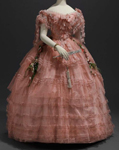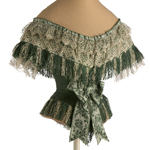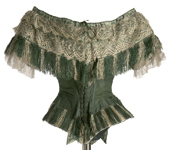démodé
adjective: old fashioned, out of style, unfashionable [from French,
the past participle of démoder "to go out of fashion,"
from mode "fashion"].

historical research
the gowns:
|
Historical Research
Sewing Techniques: The 1850s were a transitional decade. While earlier inventors had pioneered sewing machines as far back as 1790, the machine really took off after Elias Howe patented his model in 1845. In the 1850s, most garments were sewn by hand, using a backstitch for seams requiring strength (e.g. bodice) and running stitch for those that did not (e.g. skirt). However, sewing machines were in use during this era; Cunnington notes that chain stitch machines were used early in the decade, and lock stitch towards the end (170). Farrell-Beck argues that from the 1840s through the 1860s, when machine stitching was used, it was only on the interior seams where it would not show (18). Given the fact that it was possible for sewing machines to be used in the mid-1850s, and that machine stitching looks similar to a backstitch, many of us chose to use machine stitching on our interior garment seams (as would be historically accurate) and to finish with handstitching.

UNDERPINNINGS
| Chemises: Evening chemises of the 1850s followed similar lines to those of the 1830s-60s, with low necklines, fitted yoke beneath which the chemise flares out into a triangular shape, and short sleeves (often with gussets under the arms). |
|
| Drawers: Drawers of the 1850s followed similar lines to those of the 1830s-60s, with a fitted waistband, full legs just below knee-length, crotch sewn together in front but open in back, and back closure. |
|
| Corsets: Corsets of the 1850s were more complicated than their forebears of the 1830s-40s, which had primarily been shaped through gussets; now corsets began to be cut with shaped pieces, although gussets were still used (Waugh 79). They covered from the bust to the high hip, with center front busk opening and center back lacing, and were designed to create an hourglass shape. |
|
| Crinolines: Many sources note that the cage crinoline (hoopskirt) was first advertised in England in 1856. However, Waugh quotes an unnamed contemporary source from April 1855 that describes a crinoline supported by “five rows of very thin and supple whalebone, from the hem up to the knees” (118). Given this documentation, the fact that most sources agree that the cage crinoline was developed in France (and since it therefore predated the English models, must have been developed in 1855 or 1856), and that the Empress Eugenie was the leader of French fashion, we felt comfortable determining that Eugenie and her ladies could possibly be wearing hoops in the Winterhalter portrait. These cage crinolines were dome shaped; Bradfield illustrates two hoops from 1857-60, one with four hoops in steel and another with five hoops in watch spring (197-8). |
|
| Petticoats: Hoops were covered with at least one petticoat, in order to fill out the skirt and prevent any of the wires in the hoop from showing through the outer skirt. They were generally cut in the same style as skirts: straight panels, gathered to a fitted waistband. |
|

DRESSES
| The Winterhalter dresses perfectly capture evening styles of the mid-1850s. According to Cunnington, evening dresses were flounced in skirt, sleeves, and over the bodice (bertha trimmings), creating a shape that “floated like a diaphanous halo” (183). Evening dress in 1853-55 usually featured a low neckline, long V point waistline in front and short V in back, bertha of tulle or lace, ribbon bows on the shoulders, short sleeves with lace falls or puffs, and flounced skirts (either 3 wide or 7 narrow) (Cunnington 178-85). Popular trimmings included lace flounces, elaborate flowers, and ribbon knots.
|
 |
Ball dress showing the "diaphanous halo" effect, with flounces, bertha, center front and shoulder ribbons, and floral trimmings (1858)
|
Bodices: Evening bodices were cut with center front seams, princess seams at side front and back, and center back openings; shoulder seams slanted towards the back (Farrell-Beck 13). Bodices were flatlined, of cotton or glazed Silesia; the seam allowances were stitched down to the lining. Pads could be used to fill out the area between the bust and the armscye. Bodices were boned at center front, side front, side seams, and center back (Cunnington 170) and closed with eyelets and cord or hooks and eyes. While whalebone was most used in the period, it is obviously not an option today; interestingly, Farrell-Beck notes wire bones encased in cloth as early as 1892 (14). Bodices were stiffened and protected with handmade self-fabric bias cording; usually at the neckline, waistline (often double piped), and armsyce, although the side seams and shoulders could also be piped (Farrell-Beck 14). |
|
Evening dress bodice shows piping at neckline, armscye, and waistline (1850-55)
|
 |
 |
 |
|
Evening bodice showing bertha trimmed with lace and fringe, and center back lacing with eyelets (1855-65)
|
Evening dress interior shows flatlining, boning (in casings), seams unfinished, piped edge used as binding, eyelet lacing holes (1860s)
|
Janet Arnold patterns a bertha from a day dress of 1839-45. The base is of coarse stiffened muslin, with folded strips of dress fabric sewn on top; the bottom pleat folds to the back to form a facing; a crossway strip covers the center front (Patterns of Fashion, 66). An evening dress from 1865 shows strips covering the center front and side seams of the bertha (Johnston 86-7).
An evening dress of 1856-57 is show in Costume in Detail. It has stitch lines at the neckline where a bertha once was; the neckline, waistline, and armscye are piped; it is boned at the center front, sides, and center back; laces shut in back through eyelets; the skirt is turned in and gathered to a tape, then sewn to the bodice (Bradfield 195-6). |
|
Wedding dress showing bertha with strips covering center front and side seams, lace trimmings, and tucker (1865)
|
| |
The tucker – the small strip of white fabric basted to the neckline – was both a decorative element (it mimicked the chemise), provided modesty (it hid any cleavage), and protected the dress from the skin. While some of the tuckers in the painting look very flat, we found this impossible to reproduce. This probably has to do with trying to attach fabric cut on the straight to a curved seamline! (Winterhalter was smoking crack, we decided). |
|
|
Most tuckers in the painting appear very flat.
|
Attempt at reproduction does NOT work.
|
| |
|
|
|
A few tuckers in the painting appear more gathered, perhaps to some kind of ribbon (as seen in image at right)?
|
This tucker, from a portrait of Princess Alice by Winterhalter in 1861, shows a gathered tucker that is attached to some kind of ribbon near the top. Could this create the flat look seen in the Eugenie painting?
|
| |
|
|
|
Extant tuckers are often gathered. This one is gathered to a colored ribbon (1860).
|
|
Skirts: Skirts were cut in straight widths of fabric (gores did not appear until 1859) (Arnold “Changing Line,” 18). Seams were sewn with running stitches (Farrell-Beck 15-16). Skirt finishing was usually much less meticulous than the bodice – until the 1840s, skirts rarely had a lining (the petticoat served to separate the body and skirt, plus a lining isn’t practically needed for a loosely fitted garment); after 1848, skirts could have underlinings or separate “foundation skirts” (only attached at the waistband) (Farrell-Beck 17). Skirts could be hemmed by turning up the skirt fabric, or by attaching a separate facing; both were sewn with a blind hemstitch or running stitch (Farrell-Beck 17). In France, hems could be finished with a “foundation net” (a backing of plain crinoline) or with worsted braid (Farrell-Beck 18). Noted nineteenth-century costume expert Elizabeth Stewart Clark notes that skirts were cartridge or knife/box pleated, either directly to the bodice, or to a waistband (which was then tacked to the bodice). Flounced skirts were popular from 1845 through the 1860s; they usually consisted of three wide or seven narrow flounces (Arnold “Changing Line,” 17).
Janet Arnold patterns two flounced skirts – a day dress of 1852-56 and a wedding dress of 1856-60. Both have base skirts cut in straight panels. The 1852-56 dress has the flounces gathered over a cording; the skirt is cartridge pleated to the bodice. The 1856-60 dress has the flounces gathered without a cord, and is knife pleated to the bodice (Arnold Patterns of Fashion, 68-9). |
|
|
Dress with flounced skirt showing three tiers and scalloped edges - 1854-58 |

WORKS CITED
Arnold, Janet. “The Changing Line of Women’s Dress, 1830-1860,” in Early Victorian Costume, 1830-1860: Proceedings of the Third Annual Conference of the Costume Society, 1969. London: Victoria and Albert Museum, 1969.
Arnold, Janet. Patterns of Fashion: Englishwomen’s Dresses & Their Construction. New York: Drama Book Specialists, 1972.
Bradfield, Nancy. Costume in Detail: Women’s Dress, 1730-1930. London: Harrap, 1981.
Clark, Elizabeth Stewart. Posting to The Sewing Academy @ Home. June 21, 2007; Personal conversation.
Cunnington, C. Willett. English Women’s Clothing in the Nineteenth Century. London: Faber and Faber, 1956.
Farrell-Beck, Jane. “Nineteenth Century Construction Techniques: Practice and Purpose.” Dress 13 (1987): 11-20.
Johnston, Lucy, Marion Kite, and Helen Persson. Nineteenth-Century Fashion in Detail. London: V&A Publications, 2005.
Waugh, Nora. Corsets and Crinolines. London: Batsford, 1954. |

